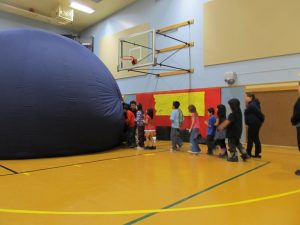
NUIQSUT — Snow whips through the streets, stinging the skin and piling up in dunes. It is springtime in Nuiqsut, blinding white, 1 degree Fahrenheit with a 30 mile-per-hour wind.
A few dozen kids are not feeling the bite, as they play in the gym of the Nuiqsut School (home of the Trappers). They are some of the 174 students here in this building, the largest structure in this village 15 miles from the sea ice of the Arctic Ocean and three feet above sea level.
As the kids shoot baskets, their dark eyes dart to a far corner, where a two-story blue canvas structure that looks like an igloo is inflating. The dome weighs 100 pounds, as does an accompanying box with a special projector inside. Lori Schoening has brought them from Fairbanks. I am here to help her carry things.
I’ve known Lori for 20 years. She works for UAF’s Geophysical Institute like I do. She is part of the team that developed the program kids will see projected inside the dome: A 20-minute movie with a sky full of Aurora, science animations and Inupiaq elders telling northern lights legends they heard when they were young. During two days, all the Nuiqsut students will file into the dome in groups of 15 or so.
One hundred seventy-four is a lot of school kids for a village of 411 people. The principal says more students are enrolling each month.
A reason Nuiqsut may be growing is that the village sits in oil country. The Alpine oil field, a major complex on the North Slope, is just 13 miles away on a gravel road. Nuiqsut is on a western channel of the Colville River. Alpine is over a bridge on the other side of that channel.[xyz-ihs snippet=”Adsense-responsive”]Oil wells and their expansive gravel pads dot the tundra around Nuiqsut. Companies are prepping to drill new ones less than five miles from the village. Many villagers receive dividend checks from oil companies developing prospects on their land.
Seen from a satellite at night, this northern slice of Alaska glows like Las Vegas. Though Nuiqsut resembles many other villages at first look, a new full-size pickup truck or SUV is parked in front of many houses.
Oil money and what it brings may or may not play a part in Nuiqsut Trapper School being a tough place to recruit teachers. Most of the staff are veterans of other bush schools, hired in January as emergency replacements for teachers who left.
As the kids squeeze into the dome for the show, a few are overexcited. One pulls up a skirt of the inflated dome and rolls a quarter outside. It wheels along the gym floor and smacks into the wall.
Other kids are quiet, somewhat stunned by this theater experience in a place without a cinema. They emerge blinking from the dome back into the fluorescent lights of the gym.

In the movie that Lori helped make and the U.S. Department of Education funded, the Inupiaq elder speakers are from Kotzebue, Nome, Utqiagvik and Shishmaref. They tell an Inupiat tale of the northern lights — how they will swoop down to chop off your head and use it for a football.
Nuiqsut teacher and native Bernice Kaigelak, 52, confirms hearing a similar story when she was little.
“When we were out it was always keep your hood on or (the northern lights) will take your head and play ball with it,” she said. “And if they scare you, you throw frozen dog poop at them and they will go away. For years, we didn’t know if it was myth or the truth.”
After five shows in the afternoon, Lori offers evening sessions so parents can see the planetarium. Only one parent shows, but a few dozen kids show up.
Some have seen the show already; others are due to see it tomorrow. I think a double viewing might make for some disorder, but Lori says she’ll deal with their fiddling and noise so they can again see a movie starring people who look like them. Some are related to the speakers in the movie.
At 7 p.m., Lori and I are ready to deflate the dome for the night. Just then, the principal walks one more kid into the gym.
Brandon Barnes is 10. He is in fourth grade and wears a blue shirt that says “I’m Inupiaq.”
I lead Brandon inside the 14-foot dome and hit the play button for the show. Northern lights spill over the sky. Elders tell their stories and a narrator tells us of the sun’s essential role in creating the aurora. Brandon stares upward at the projection. For 20 minutes, he does not say a word, or move.
Brandon’s teacher said he is a smart kid who will go places if he gets the opportunity. When he exits the dome, I give Brandon knuckles for being good and ask him what he thought.
“I thought it was amazing,” he said. “I love the parts when you were in space; it was so realistic. I’m really hoping you guys will come back soon.”
Video shown in portable dome. University of Alaska-Fairbanks
Since the late 1970s, the University of Alaska Fairbanks’ Geophysical Institute has provided this column free in cooperation with the UAF research community. Ned Rozell is a science writer for the Geophysical Institute.
